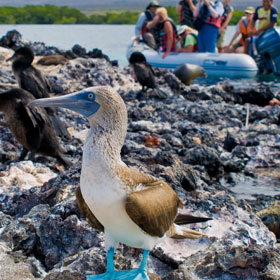Seaman Journey
M/C Galapagos Seaman Journey is a first class catamaran, offering superior comfort, size, style, and stability! Walk, swim, snorkel, kayak. Explore.
Day 1 – Friday
Mainland – Baltra Santa Cruz Island
AM: Flight to Galapagos from Quito or Guayaquil Airport
The flight from Quito to the Galapagos is approximately 2 ½ hours on a Boeing 727. Upon arrival at Baltra travelers pass through an airport inspection point to insure that no foreign plants or animals are introduced to the islands and to pay the park entrance fee of US$100 (unless prepaid), and US$10 for the INGALA card (unless prepaid) which is an identity card that you need . Guides will meet you, collect your luggage, and escort you on the short bus ride to the harbour. Motorized rafts, called ‘Pangas’ will transport you to the M/C Galapagos Seaman Journey and our crew will welcome you onboard. After departure and lunch, the first island visit is made.
PM: North Seymour
Is an uplifted (as opposed to volcanic) island and so is generally flat and strewn with boulders. There are good nesting sites here for a large population of magnificent frigate birds. Blue-footed boobies perform their courtship dance in the more open areas and swallow-tailed gulls perch on the cliff edges. Despite the tremendous surf that can pound the outer shore, sea lions haul out onto the beach and can be found bodysurfing. L/D
Day 2 – Saturday
Genovesa Island
AM: El Barranco
The visitor site of El Barranco is located in the southern part of Darwin Bay on Genovesa Island. The trail is on volcanic rock that has a length of 1.5 km and the tour can be done in about 2 hours. The youngest area of the island, from a geological point of view, lies in this area. The cliffs located in the south are composed of very fragile lava. The natural erosion that has occurred in these lava flows has become the ideal place for nesting Storm Petrels. You can see two species of petrels that nest in cavities and holes in the lava. One of its main predators is the short-eared owl. The red-footed booby nests only in the outer islands of the archipelago, Punta Pitt, Gardner (Floreana), Wolf, Darwin and Genovesa. Also present on this island is the masked booby. During the “panga rides” along the cliffs fur sea lions can be seen and several species of seabirds.
PM: Darwin Bay
This bay has its origin when the crater of this island collapsed below sea level. The wet landing is on a beautiful white coral sandy beach. This is a favorite island for birdwatchers: red footed-booby, masked boobies, wandering tattlers, lava gulls, whimbrels, yellow-crowned, and black-crowned lava herons, and yellow warblers can be seen in the area. Continuing on the trail, visitors climb gradually to the edge of the cliff seeing Red-Foots nesting in the Mangrove trees below. Bird watching includes sightings of sharp-beaked finches, large cactus and ground finches, Galapagos doves, and swallow-tailed gulls. Reaching the end the trail at the cliff’s edge offers an incredible view of the island and the many birds living there. B/L/D
Day 3 – Sunday
Santa Cruz Island – Santa Fe Island
AM: Plazas
Plazas is located at the east of Santa Cruz Island, and forms part of two islands known as Islas Plazas. Despite its small size, some of the most interesting and outstanding species of the Galapagos are found here. The Plazas land iguanas are smaller than its relatives found at other islands. Throughout the island are several hybrid iguanas, a result of crossing a male marine iguana and a female land iguana, they are unique, recognizable at first glance by their black/gray color, with a land iguana’s crest, but face and tail of the marine iguana. The big population of iguanas is due to the presence of tunas, their favorite food. Swallow tailed gulls nesting in the rugged cliffs are seen along with other sea birds as: Audubon shearwaters, red-billed tropicbirds, frigate birds, and brown pelicans.
PM: Santa Fe
Located in the southeastern part of the Galapagos, this island was formed from an uplift instead than a volcanic origin, this is why is mostly flat. There are some theories which assure this could be the oldest island in the Archipelago. Santa Fe is the home of a number of endemic species like the Galapagos hawk, Galapagos snake, Galapagos mockingbird, rice rats, and one of the two species of lands Iguanas of the islands. After disembarking in the beautiful and clear waters you will be in contact with one of the many sea lion colonies. Along the trail many salt bushes can be seen as well giant Pickly pear cactus, gigantism is a characteristic of oceanic islands. There are great possibilities of snorkeling with playful sea lions and tropical fishes. B/L/D
Day 4 – Monday
San Cristobal – Mainland
AM: Interpretation Centre
The Interpretation Centre’s lush gardens and sweeping ocean views are a strong contrast to the 1960’s style buildings at the Charles Darwin Center. Visitors to the Interpretation Center can learn about both the geological and human history of the islands, conservation issues, and natural history. The older Museum of Natural History attempts to preserve the natural history of the islands. After the morning excursion you will be transferred to Baltra airport for your return flight to the mainland, either Quito or Guayaquil.
B.
Photo at top of page by Magdalena Kula Manchee on Unsplash.
Tour Cost








